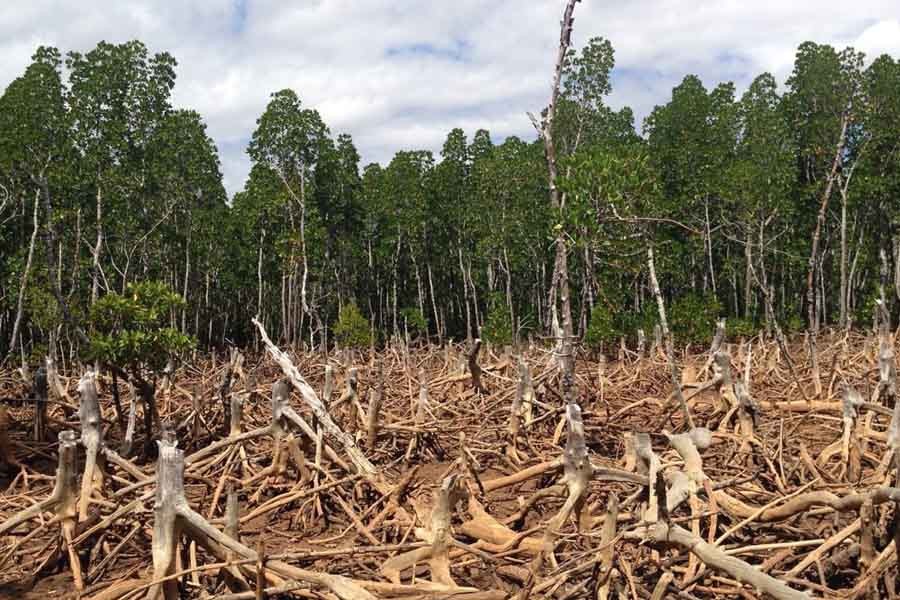Encroaching on forests and building habitats and other establishments has been a major human trait since the dawn of civilisations. As humans came out of their improvised primitive shelters and began cultivating lands, the woodlands started thinning out. Later, livelihood-related activities requiring land masses dealt a major blow to forests. The phase of the disappearance of the forests started in earnest. However, large countries with vast expanses of forest-cover were able to face up to the process of this depletion --- its pace increasing with time. Against the backdrop of the continued rise in environmental awareness, many of today's industrialised countries took steps to make up for the losses already incurred. They strictly enforced the mandatory provision of afforestation for people, especially those who have cleared up forests for different socio-economic projects.
Compared to the global trends of forest depletion and preventive measures, the case of Bangladesh appears to be miserable. Vast segments of the country's already depleted forests continue to be gobbled up by public and private entities. All of them set their eyes on these forest-lands to set up this or that project. They range from industries, economic zones, to tourist spots and recreation centres. That the authorities of a small country with even a smaller size of forest coverage can acquiesce to the demands of industrial units is apparently not a great riddle. It plainly points to the unscrupulousness of a section of entrepreneurs. The isolated and individual activities of forest clearance have long been overshadowed by the giant deforestation bids for development projects under state patronage. Pessimists might feel tempted to liken this 'policy' to hara-kiri of sorts.
According to the international environmental law, a country must keep in reserve 20 per cent of its total land mass for woodlands. Presently, Bangladesh has a little over 17 per cent of land under forest coverage. The area under direct jurisdiction of the Department of Forest (DoF) comes to 10.84 per cent. The statistics offers a dismal picture. When it comes to the protection of forests, Bangladesh appears to be lagging behind even many arid countries plagued by prolonged civil wars and environmental catastrophes. The mindless way the country is dealing with the leftover of its past forest resources portends a gloomy future. This being the stark reality, the government continues to tell the nation of its great missions. It has been learnt lately that the government aims to put the brakes on deforestation by 2020. And in conformity with meeting the SDG (Sustainable Development Goal), it will bring 20 per cent of the country's land mass under forests by 2030 --- with 70 per cent tree density. It sounds highly impressive. There are potent elements in the goal to take heart from. These types of promises are not new in the country, though.
There are some extraordinary features. Small countries like Bangladesh are faced with a dilemma. Few of them want to part with their green swathes. For Bangladesh, its vast population emerges as a great problem. It's a paradoxical situation. On one hand it has to keep sufficient forest-lands, on the other it has to provide settlements for people, and keep pace with the global march of economic and industrial development. The latter imperative invariably targets the country's forests. Being a deltaic and swampy land in the main, Bangladesh has witnessed the abundant growth of lush green and dense forests and shrubbery since its ancient times. Woodlands comprise a large part of the country's central region. The southern coastal belt witnesses a long stretch of forests. They include the world's largest mangrove forest, the Sundarbans. The forests in the northern and north-eastern parts of the country are geologically considered the extension of the forest range grown at the foot of the Himalayas. The south-eastern forest-dominant hilly region is geologically viewed as a part of the Indo-Burman mountain range. Even in the early 20th century, the whole Bangladesh was dotted with patches of mainland marshy forests. Those were different from the ones growing in hill and mountain ranges. The scourge of forest depletion and clearance, or grabbing to be precise, began afflicting the nation in the later part of the last century. The thousand-year-old woodlands had to bear the brunt of the sudden rise in the mobility of people. It occurred throughout the country with displaced or homeless people searching for suitable abodes. After the country's independence in 1971, indiscriminate setting up of development infrastructure at the forest sites appeared to have driven the last nail in the coffin. Atrociously ill-planned projects with no vision and future road map added to the unabated deterioration of the scenario.
Many would feel like viewing the present plight of the country's forests as a distressing and continued extension. But the point is the disappearance of forests has to be stemmed. Without trees and woodlands, Bangladesh's ecological balance and biodiversity are destined to go haywire. The scourge is feared to play havoc with the country's environmental set-up, not to speak of its disastrous impact on the nation's sound survival in all respects.


